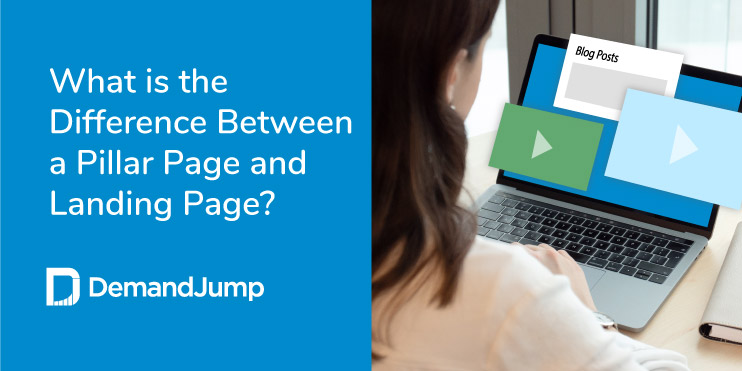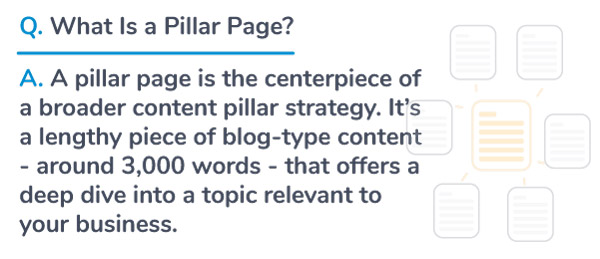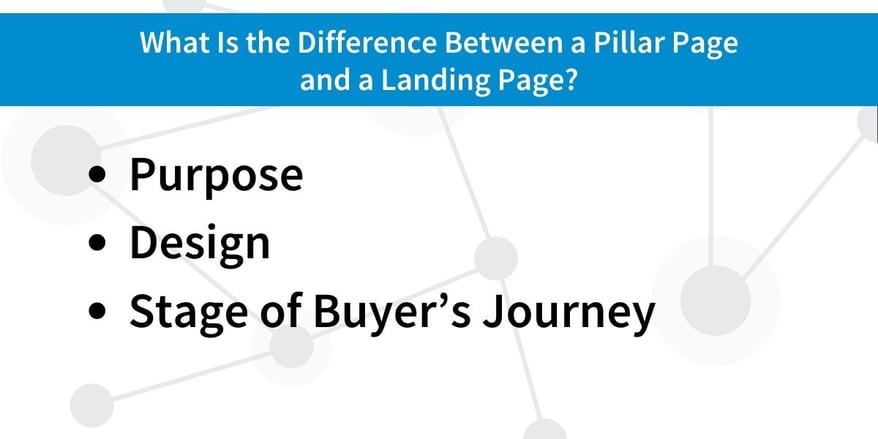What is the Difference between a Pillar Page and Landing Page?
March 23, 2022 •Shannon Elward

One question we hear a lot is, “Is a pillar page a landing page?” At the risk of throwing out an ambiguous response, the answer is yes and no. An SEO pillar page and a landing page are not the same thing, and they’re not intended to serve the same function. One is designed to build up a brand’s authority on a particular topic, and the other is intended to serve as a place to send and convert visitors to various campaigns.
With that said, a pillar page and a landing page can exist on the same webpage—although they certainly don’t have to. In our minds, the age-old a square is a rectangle, but a rectangle isn’t a square discussion seems particularly applicable to this question. In this blog, we’ll be taking a look at the key differences between pillar pages and landing pages. But before we dive into the differences between a pillar page vs a landing page, let’s briefly take a look at the high-level features of both.
What Are Pillar Pages?
A pillar page is essentially a long-form piece of SEO-driven content (generally around 3,000 words). There are a few different types of pillar pages, including guides, how-to articles, resource articles, and more. If you click on that “SEO pillar” link in the first paragraph, you can see one of our own pillar pages yourself. What makes a good pillar page? It should do two things very, very well.

First, a pillar page should use SEO keywords and phrases to help your content rank better and higher on Google and other search engines. As digital marketers, we all know that ranking higher on Google is always good. And with pillar pages, you can use 15 or more keywords to outrank your competitors for many relevant phrases.
Second, a pillar page can become an authority on any given topic with the right pillar strategy in place. What exactly does that mean? A pillar strategy contains a number of different articles, including a pillar (what we’re talking about now), sub-pillars, and supporting blogs. All the sub-pillars and supporting blogs link up to your pillar, which signifies to Google—and your visitors—that you’re an authority.
DemandJump's podcast, Page One or Bust!, often discusses Pillar-Based Marketing best practices. In the clip below, some of DemandJump's writers discuss how to construct their Pillars. For the full episode, visit this link.
What Are Landing Pages?
Landing pages are web pages—or a part of a webpage—that a customer “lands” on when they click on a link on an ad, in an email, on social media, or more. A hallmark of a landing page is that it’s generally not in a website’s navigation menu. It’s designed to serve a specific purpose—and that’s receiving people who click on your link.
Landing pages are generally fairly text-light. Unlike a pillar, they’re not generally trying to educate or inform your audience about a whole bunch of different things. Instead, they’re going to provide a very narrow value proposition and try to get your visitor to take one specific action. That might be signing up for a demo, entering their contact information to download a whitepaper or ebook, or signing up for a mailing list. That singular conversion is key. A landing page with too many potential actions is likely going to overwhelm your visitors and cause them to click off. Keep it simple.
What Is the Difference Between a Pillar Page and a Landing Page?
While there are numerous differences between pillar pages and landing pages, let’s look at three of the most important differences.
Purpose
To put it succinctly, a pillar page uses SEO to acquire traffic and educate them on a particular topic. A landing page attempts to convert visitors.
Design
Pillar page design usually looks like just a big, long article. Often you’ll see big chunks of content (remember, it’s about 3,000 words), with headers to make it more skimmable. You might also notice a bunch of links to other similar articles in a sidebar.
Landing pages, on the other hand, are generally text-light. They might have some graphics, icons, and small snippets of text trying to convince visitors to convert. They’ll typically contain a form to enter a name and basic contact information.
Stage of Buyer’s Journey
A pillar page is almost always going to meet buyers at their awareness or consideration phase. It’s a long page with a lot of broad information to inform visitors on a topic. While it can and should include some information about your product or service, it should educate above all else. However, a landing page can be designed to fit any stage of the buyer’s journey, from awareness to loyalty.
So when do a pillar page and a landing page exist on the same webpage? Some companies find great results by having their landing page information and call to action (CTA) above the fold and a pillar page below the fold. That allows visitors to perform an action without much scrolling, and it gives the page incredible SEO value.

DemandJump: Get Insights and Drive Outcomes
Digital marketing is complicated. The rules are constantly changing. Trying to get Google’s attention without a solid plan is like trying to hit a moving target when you don’t even have an arrow. That’s why we created DemandJump. DemandJump is the number one marketing strategy platform that shows you the exact content you need to create to increase your first-page rankings and drive better outcomes for your business. With our platform, you can know exactly what content to create, save time creating your content calendar, and generate one-click SEO content briefs to get started writing content immediately.
Featured Articles
Categories
- Attribution Tracking (13)
- Channel Optimization (11)
- Consumer Insights (68)
- Content Marketing (251)
- Data Science (8)
- Digital Marketing (6)
- Digital Transformation (26)
- Enterprise (10)
- Lead Generation (14)
- Market Intelligence (8)
- Marketing Analytics (39)
- Marketing Attribution (57)
- Marketing Management (153)
- Marketing Operations (86)
- Organic Search (222)
- Paid Search (52)
- Pillar-Based Marketing (63)
- Programmatic Advertising (9)
- SaaS Content (14)
- SaaS Marketing (29)
- Search Marketing (111)
- SEO Keyword Research (28)
- SEO Pillar (18)
- SEO Strategy (46)
- SMB (5)
- Website Content (12)


